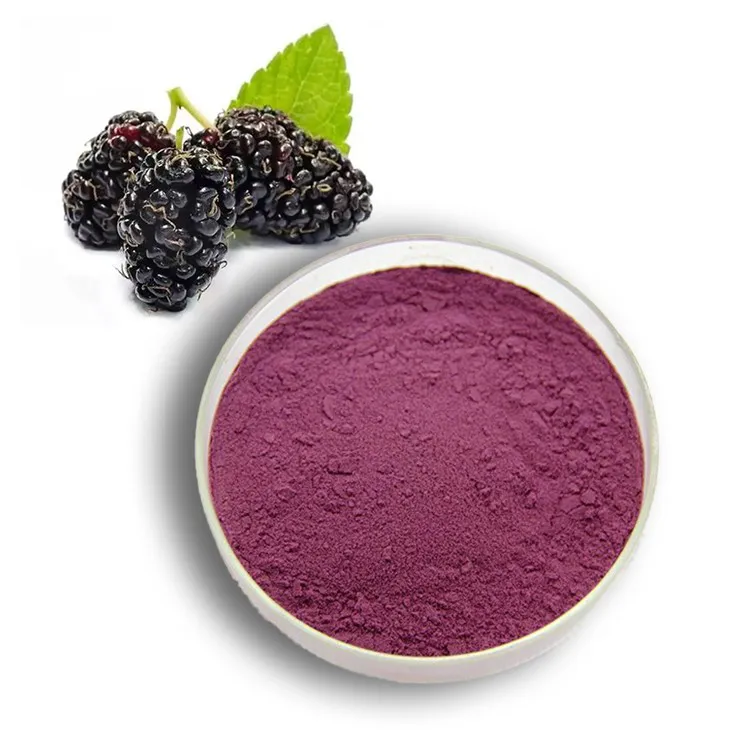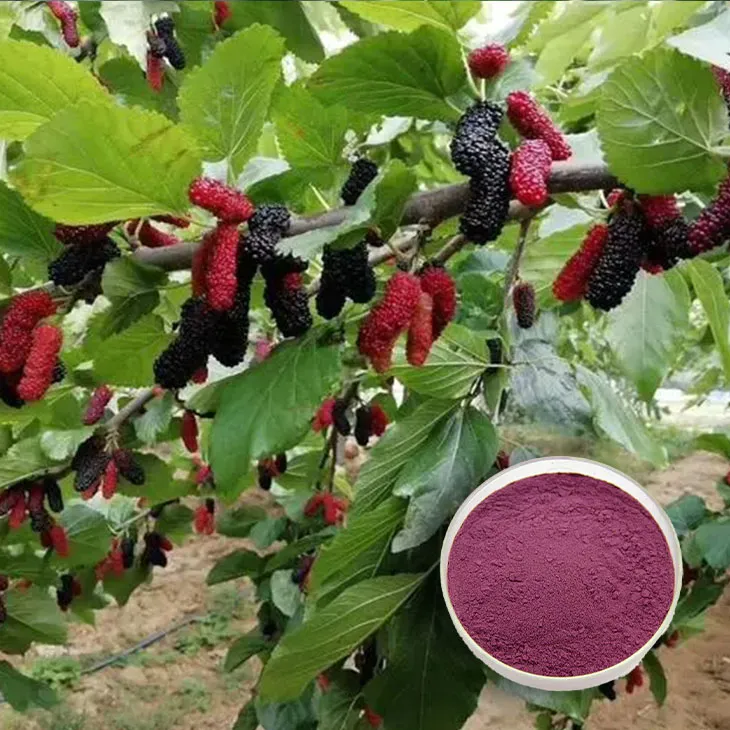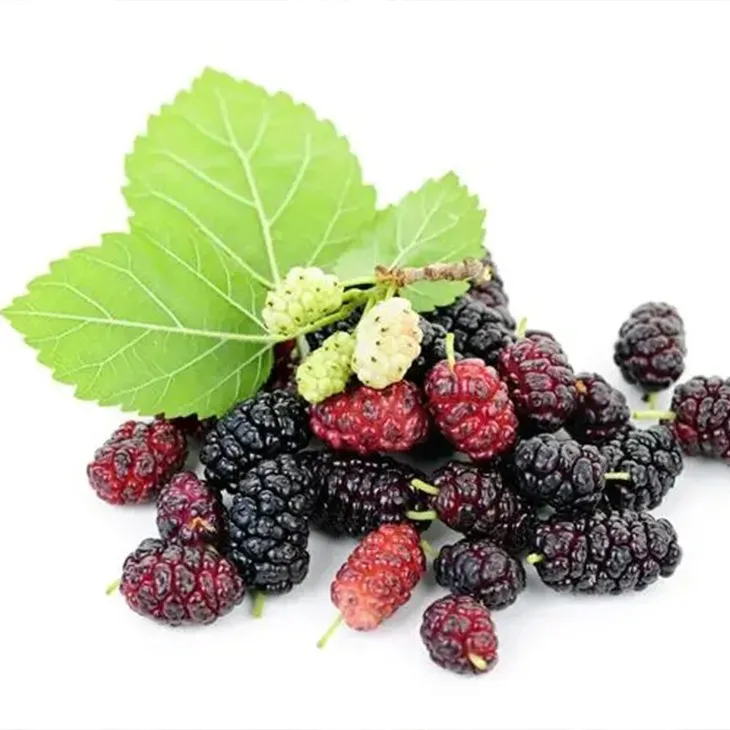- 0086-571-85302990
- sales@greenskybio.com
Active components in mulberry extract.
2024-11-29

Introduction
Mulberry, known as Sang - shen in traditional medicine, has a long - standing reputation. The extract of mulberry is rich in a variety of active components, which make it a subject of great interest in different fields such as medicine, cosmetics, and functional foods.

Flavonoids in Mulberry Extract
Flavonoids are one of the crucial active ingredients in Mulberry Extract. These compounds are well - known for their antioxidant properties.
Antioxidant Mechanism
Flavonoids can effectively scavenge free radicals within the body. Free radicals are highly reactive molecules that can cause oxidative stress. Oxidative stress, in turn, is associated with various health problems as it can lead to cell damage. By neutralizing free radicals, flavonoids play a significant role in maintaining the normal physiological state of cells and tissues. For example, they can protect the cell membranes from lipid peroxidation, which is a common consequence of free - radical attack on lipids in the cell membranes.

Anthocyanins in Mulberry Extract
Anthocyanins are another important component present in mulberry extract. They are responsible for the characteristic deep - purple color of mulberries.
Antioxidant and Anti - inflammatory Effects
Similar to flavonoids, anthocyanins are also powerful antioxidants. They are capable of donating electrons to free radicals, thereby converting them into less reactive species and reducing the overall oxidative stress in the body. Moreover, anthocyanins may have anti - inflammatory effects. Inflammation is a natural immune response, but chronic inflammation can be harmful and is associated with many diseases such as arthritis, cardiovascular diseases, and certain cancers. Anthocyanins can potentially modulate the inflammatory response by interacting with various signaling pathways involved in inflammation. For instance, they may inhibit the production of pro - inflammatory cytokines, which are small proteins released by cells that play a key role in inflammation.

Alkaloids in Mulberry Extract
Alkaloids in the mulberry extract also contribute to its biological activities. These compounds are known to play a role in regulating physiological functions.
Interaction with Receptors
Alkaloids may interact with certain receptors in the body. For example, they could interact with receptors involved in neurotransmitter release. Neurotransmitters are chemicals that transmit signals between nerve cells (neurons). By influencing neurotransmitter release, alkaloids can potentially affect various neural functions such as mood regulation, cognitive functions, and even motor control. However, the exact mechanisms of these interactions are still the subject of ongoing research.
Potential Applications of Mulberry Extract
Due to the presence of these rich active components, mulberry extract has a wide range of potential applications.
Medical Applications
- Antioxidant - related diseases: Given the antioxidant properties of flavonoids and anthocyanins, mulberry extract may be beneficial in preventing and treating diseases associated with oxidative stress. For example, it could potentially be used in the management of neurodegenerative diseases like Alzheimer's and Parkinson's, where oxidative stress is thought to play a significant role in the progression of the diseases. - Anti - inflammatory uses: The anti - inflammatory effects of anthocyanins make mulberry extract a possible candidate for treating inflammatory conditions. It could be explored for use in reducing inflammation in conditions such as rheumatoid arthritis or inflammatory bowel diseases.
Cosmetic Applications
- Skin health: The antioxidant properties of mulberry extract can be harnessed in cosmetics. It can help protect the skin from damage caused by free radicals, which are often generated by environmental factors such as ultraviolet (UV) radiation and pollution. This can potentially lead to a reduction in skin aging signs such as wrinkles, fine lines, and age spots. - Hair health: Mulberry extract may also have applications in hair care products. It could potentially improve hair health by providing antioxidant protection to hair follicles, which may help in preventing hair loss and promoting hair growth.
Functional Food Applications
- Nutritional supplements: Mulberry extract can be used as a component in nutritional supplements. Its rich content of active components can provide additional health benefits when consumed as part of a balanced diet. For example, it can be added to multivitamin supplements or antioxidant - rich blends. - Food fortification: In the food industry, mulberry extract can be used for food fortification. It can be added to various food products such as juices, yogurts, and cereals to enhance their nutritional value. This allows consumers to obtain the benefits of mulberry extract in a more convenient and palatable way.
Conclusion
In conclusion, the mulberry extract contains a diverse range of active components including flavonoids, anthocyanins, and alkaloids. These components endow the extract with antioxidant, anti - inflammatory, and physiological regulation properties. The potential applications of mulberry extract in medicine, cosmetics, and functional foods are vast and hold great promise for future development. However, further research is still needed to fully understand the mechanisms of action of these components and to optimize their applications in various fields.
FAQ:
What are the main active components in mulberry extract?
The main active components in mulberry extract include flavonoids, anthocyanins and alkaloids. Flavonoids have antioxidant properties. Anthocyanins are powerful antioxidants and may have anti - inflammatory effects. Alkaloids play a role in regulating physiological functions.
How do flavonoids in mulberry extract function?
Flavonoids in mulberry extract possess antioxidant properties. They can effectively scavenge free radicals in the body, reducing oxidative stress and preventing cell damage.
What is the role of anthocyanins in mulberry extract?
Anthocyanins in mulberry extract are responsible for the deep - purple color of mulberries. They are powerful antioxidants and may also have anti - inflammatory effects, which can help relieve inflammation in the body.
How do alkaloids in mulberry extract regulate physiological functions?
Alkaloids in mulberry extract may interact with certain receptors in the body, influencing processes such as neurotransmitter release, thus playing a role in regulating physiological functions.
Why is mulberry extract a promising candidate for various applications?
Mulberry extract is a promising candidate for various applications because it contains rich active components such as flavonoids, anthocyanins and alkaloids. These components endow it with antioxidant, anti - inflammatory and physiological function - regulating properties, making it applicable in the fields of medicine, cosmetics, and functional foods.
Related literature
- Antioxidant Activity of Mulberry (Morus alba L.) Extracts: A Review"
- "Bioactive Compounds in Mulberry and Their Potential Health Benefits"
- "Mulberry Extract: Chemical Composition and Pharmacological Properties"
- ▶ Hesperidin
- ▶ citrus bioflavonoids
- ▶ plant extract
- ▶ lycopene
- ▶ Diosmin
- ▶ Grape seed extract
- ▶ Sea buckthorn Juice Powder
- ▶ Beetroot powder
- ▶ Hops Extract
- ▶ Artichoke Extract
- ▶ Reishi mushroom extract
- ▶ Astaxanthin
- ▶ Green Tea Extract
- ▶ Curcumin Extract
- ▶ Horse Chestnut Extract
- ▶ Other Problems
- ▶ Boswellia Serrata Extract
- ▶ Resveratrol Extract
- ▶ Marigold Extract
- ▶ Grape Leaf Extract
- ▶ blog3
- ▶ blog4
-
How to make powder with selenium yeast?
2024-11-29
-
Chinese β - Carotene Suppliers
2024-11-29
-
Lycopene Manufacturers from China.
2024-11-29
-
Organic plantain extract powder factory.
2024-11-29
-
The best calendula extract on the market.
2024-11-29
-
100% Organic Baicalin.
2024-11-29
-
Fenugreek Extract Powder
2024-11-29
-
Natural grape seed extract
2024-11-29
-
Lemon Balm Extract
2024-11-29
-
Lemon Juice Powder
2024-11-29
-
Boswellia Serrata Extract
2024-11-29
-
Sophora Japonica Flower Extract
2024-11-29
-
Lotus leaf extract
2024-11-29
-
Cactus Extract
2024-11-29
-
White mustard seed extract
2024-11-29
-
Resveratrol extract
2024-11-29





















